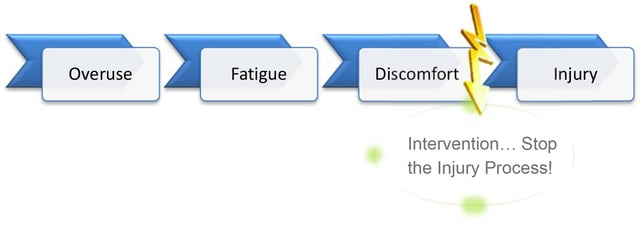When exercise is recommended for a musculoskeletal symptom, do you record it on your OSHA log?
By Lori Deal, PT, DPT
Part II To Record or Not To Record
As the employer, you are in a prime position to help your employees by offering help early when symptoms arise. You and the employee ultimately decide what the solutions are when symptoms arise.
Solutions might include:
- The employer taking precautions by having the employee avoid certain tasks for a few days, but less than a week.
- Consulting with onsite health personnel such as a Physical Therapist, Athletic Trainer, Nurse, or Occupational Therapist.
- Consulting a physician.
Each solution is intended to resolve the symptoms. Any or all may resolve the symptoms without the need for filing a Workers’ Compensation claim OR recording a case on an OSHA log.
However, depending on the circumstances, the solution may result in the employer logging an OSHA case, and/or filing a Workers’ Compensation claim in order to resolve the symptoms.
If your company’s perspective is that OSHA recordables are undesirable, it will affect what solutions are identified in response to employees identifying work-related symptoms, such as pain. If an employee identifies symptoms as non-work-related, they can be addressed with a different range of solutions than if the symptoms are identified by the employee as work-related. Those with non-work-related symptoms are not recordable, regardless of the interventions provided. It is important to address your employees’ symptoms whether they arise from work or non-work-related activities, as they may impact productivity, health, safety, morale or get worse if unattended to.
There are often questions surrounding recordability when an employee reports symptoms that he or she identifies as work-related. OSHA recording handbook and the interpretive letters in response to its provisions, are a great resource for determining whether a situation is recordable in the OSHA log or not. However, there are varied topics with numerous interpretations regarding recordability.
If your company relies on statistics from your OSHA log and/or from claims data to benchmark your safety record, or bid for work, it is important to know whether a pre-injury symptom is recordable on your OSHA log or not. Consistency in methods for recording cases is important if you are using the OSHA log as a performance indicator. Depending on your company’s philosophy around OSHA recording, graded levels of intervention can be provided to those employees who have work-related symptoms.
With musculoskeletal disorders (MSD) (i.e. sprains, strains, cumulative trauma, repetitive motion) driving a significant number of recordables and claims in most industries, let’s look at an example of one event that might or might not be recordable on the OSHA log.
Scenario:
Your employee has just informed you that she “tweaked her back” lifting a box of apples from the floor, which is a task she does in the workplace. She indicates she does not want to go to the doctor, but she would like to see the onsite clinician to make sure she doesn’t do anything to make it worse. Is this recordable? No.
She then sees the clinician, who instructs her in proper body mechanics of lifting and best practices. Is this recordable? No.
The clinician also gives her suggestions about taking care of the problem at home, such as resting and proper positioning. Is this recordable? No.
The clinician applies ice to the affected area while she consults with the employee. Is this recordable? No.
Then the clinician gives her exercises to do to ensure she stays strong and flexible and prevents the problem from getting worse. Is this recordable? It depends…
Exercise that is part of a general wellness plan that employees participate in, such as exercise the employee performed prior to her symptoms, is something she may continue, and the event is not recordable (see interpretive letter dated 5/20/2011 related to standards 1904.7(b)(5)(ii); 1904.7(b)(5)(ii)(M); 1904.7(b)(5)(iii), www.osha.gov). However, if the clinician gave her specific, written instructions, including sets and repetitions of an exercise in direct response to symptoms, the case would be recordable. The employee would not be required to go to a physician or file a Workers’ Compensation claim.

The bottom line is that recording a case in the OSHA log should never be a deterrent to doing the right thing for the employee. Taking care of your workforce will pay dividends. Risk identification and risk solutions can be tailored to your needs and preferences and can help you get ahead and stay ahead of the injury curve.